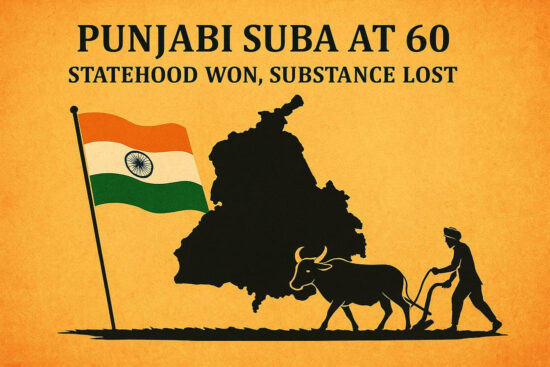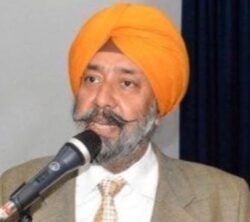 On 1 November 1966, after a decade of agitation, the Akali leadership secured the Punjabi Suba—a Punjabi-speaking state carved out in the name of language and identity. As we enter the sixtieth year of that “achievement’, I will leave it to readers to judge whether Punjabi, as a script and literature—not merely a spoken tongue—has truly flourished.
On 1 November 1966, after a decade of agitation, the Akali leadership secured the Punjabi Suba—a Punjabi-speaking state carved out in the name of language and identity. As we enter the sixtieth year of that “achievement’, I will leave it to readers to judge whether Punjabi, as a script and literature—not merely a spoken tongue—has truly flourished.
The Literacy Test: Can We Read What We Speak?
A simple test would suffice: ask every man or woman who has served as a minister since 1966 whether they, their children, or their grandchildren can read and write Punjabi with ease. Speaking Punjabi is our hearth; reading and writing Punjabi is our house. Did we build it?
The Price on the Map: Losing the Capital Belt
The price we paid is written across the map. We forfeited a vast belt abutting the national capital—an irreparable loss in demography, industry, connectivity and leverage. Today, Haryana races ahead; Punjab, once the bellwether, debates stagnation in agriculture and sits somewhere in the middle on per-capita income tables. Most galling is our diminished sense of agency. We now plead for crumbs.
Crumbs of Control: Chandigarh and Inter-State Institutions
Our capital, Chandigarh—administered as a Union Territory—remains elusive. Institutions that ought to be expressions of state competence are re-described as “inter-state” or centrally managed. We argue over the composition of Senates and Syndicates; we litigate, relitigate and then withdraw litigation. The Bhakra Beas Management Board, Panjab University as an inter-state body corporate, even the Shiromani Gurdwara Parbandhak Committee—each sits in a grey zone of divided control, contested jurisdiction and federal ambiguity. Haryana now has its own statutory gurdwara management committee; Punjab debates resolutions while others draft statutes.
The Contested Clause: Section 78 (with 79–80)
It bears stating in black and white: Section 78 of the Punjab Reorganisation Act, 1966—read with Sections 79 and 80—effectively placed the allocation and regulation of the Bhakra–Beas waters under Union direction when the successor States failed to agree. Section 78(1) empowers the Central Government to determine, by order, the proportions and adjustments of rights and liabilities relating to the Bhakra-Nangal and Beas Projects if no agreement is reached within two years of the appointed day; Section 79 then tasks the Bhakra (now Bhakra Beas) Management Board with regulating water supply having regard to that agreement or Central order, while Section 80 centralises construction and transfer of Beas Project components. These provisions have been the focus of constitutional challenge—from Punjab’s suit assailing the vires of Section 78 alongside the 1976 Union orders, to later petitions questioning Sections 78–80—yet the core questions endure.

Choices Made in Daylight
Let us be honest about choices. The largest chunk was lost not in darkness but in daylight—deliberately, consciously. Having conceded the substance, we now quarrel over symbols. We announce committees, pass resolutions and rush to microphones. Meanwhile, the patient bleeds. Our political class—cutting across parties—has preferred tactical skirmishes to strategic settlements; short-term optics to long-term outcomes. This is not merely short-sightedness. It is institutional myopia, bordering on wilful blindness.
From Optics to Outcomes: The Way Back
There is still a way back, but it begins with clarity. First, language must return from rhetoric to policy: universal Punjabi literacy in schools, administrative bilingualism that actually functions on paper, and a serious programme for digital Punjabi—corpus building, practical Unicode adoption and state support to publishing. Second, federal leverage must be rebuilt through law, not lament—time-bound litigation strategies, coalition-building with similarly placed States and hard-nosed negotiation on Chandigarh, inter-state institutions and water. Third, economic revival must pivot from minimum-risk incrementalism to structural reform—diversification beyond wheat-paddy, agro-processing and logistics, research-driven farming, and an ease-of-doing-business regime that prizes outcomes over notifications.
The Question We Cannot Dodge
Punjab is not condemned to the margins. But to step back to the centre, we must stop speaking in metaphors and start acting on metrics. In 1966 we asked for a state to protect a language and empower a people. Sixty years on, the question is starker: do we still have the will to protect the language, secure the institutions and reclaim the future? The answer will not be found in courts alone or in resolutions alone—but in leadership that has the courage to settle, not just to shout.